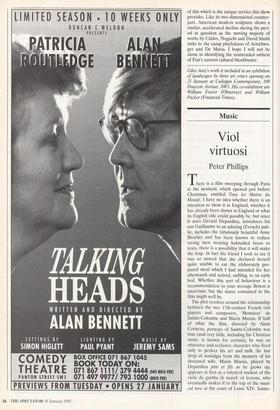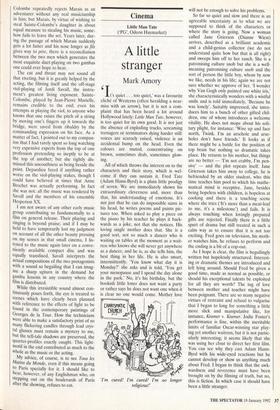Music
Viol virtuosi
Peter Phillips
There is a film sweeping through Paris at the moment, which opened just before Christmas, entitled Tous les Matins du Monde. I have no idea whether there is an intention to show it in England, whether it has already been shown in England or what its English title could possibly be, but since it stars Gerard Depardieu, introduces his son Guillaume to an adoring (French) pub- lic, includes the fabulously beautiful Anne Brochet and has been known to reduce strong men wearing hobnailed boots to tears, there is a possibility that it will make the leap. In fact the friend I took to see it was so moved that she declared herself quite unable to eat the elaborately pre- pared meal which I had intended for her afterwards and retired, sniffing, to an early bed. Whether this sort of behaviour is a recommendation to your average Briton is uncertain; but the music contained in the film might well be.
The plot revolves around the relationship between the two 17th-century French viol players and composers, 'Monsieur' de Sainte-Colombe and Marin Marais. If half of what the film, directed by Alain Corneau, portrays of Sainte-Colombe was true (and very little, including his Christian name, is known for certain), he was an obsessive and reclusive character who lived only to perfect his art and milk the last drop of nostalgia from the memory of his deceased wife. Marin Marais, played by Depardieu pere et fils as he grows up, appears at first as a talented student of the viola da gamba in search of lessons, who eventually makes it to the top of the musi- cal tree at the court of Louis XIV. Sainte- Colombe repeatedly rejects Marais as an adventurer without any real musicianship in him; but Marais, by virtue of wishing to steal Sainte-Colombe's daughter in about equal measure to stealing his music, some- how fails to leave the set. Years later, dur- ing the passage of which Marais suddenly gets a lot fatter and his nose longer as fits gives way to pore, there is a reconciliation between the two men which generates the most exquisite duet-playing on two gambas one could ever hope to hear.
The cut and thrust may not sound all that riveting, but it is greatly helped by the acting, the filming itself and the off-stage viol-playing of Jordi Savall, the instru- ment's greatest living exponent. Sainte- Colombe, played by Jean-Pierre Marielle, remains credible to the end; even his attempts at playing the viol, to anyone who knows that one raises the pitch of a string by moving one's fingers up it towards the bridge, were saved from ribaldry by the commanding expression on his face. As a matter of fact, I pointed out to my compan- ion that I had rarely spent so long watching very expensive experts from the top of one profession pretending so ineptly to be at the top of another; but she rightly dis- missed this uncouthness as being beside the point. Depardieu fared if anything rather worse on the viol-playing stakes, though I could have believed at times that Anne Brochet was actually performing. In fact she was not: all the music was rendered by Savall and the members of his ensemble Hesperion XX.
I am not aware of any other early music group contributing so fundamentally to a film on general release. Their playing and singing is beyond praise; and if I may be held to have temporarily lost my judgment on account of all the other beauty pressing on my senses in that small cinema, I lis- tened to the music again later on a conve- niently available compact disc and was equally transfixed. Savall interprets the actual compositions of the two protagonists with a sound so beguiling that I can imag- ine a sharp upturn in the demand for gamba lessons in any country where the film is distributed.
While this irresistible sound almost con- tinuously pours forth, the eye is treated to scenes which have clearly been planned with reference to the effects of light to be found in the contemporary paintings of Georges de la Tour. How the technicians were able to make a satisfactory print of so many flickering candles through lead crys- tal glasses must remain a mystery to me, but the tell-tale shadows are preserved, the quarter-profiles exactly caught. This light- motif in the end contributed as much to the whole as the music or the acting. My advice, of course, is to see Tous les Matins du Monde, even if this means going to Paris specially for it. I should like to hear, however, of any Englishman who, on stepping out on the boulevards of Paris after the showing, refuses to eat.



















































 Previous page
Previous page